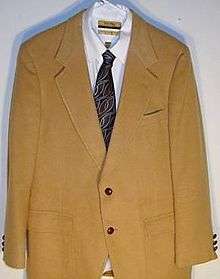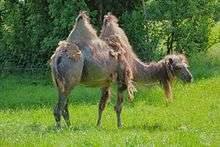Camel hair
Camel hair specifically refers to the fur from the body of a camel, but more generally refers to the fibre (and cloth) that may be made from either pure camel hair or a blend of camel hair and another fibre.

Camel hair has two components: guard hair and undercoat. Guard hair is the outer protective fur, which is coarse and inflexible and can be woven into haircloth. (Guard hair may be made softer and plusher by blending it with another fibre, especially wool.) The undercoat, which is shorter and finer than guard hair, is less protective but more insulating. It is very soft and frequently used in the making of textiles for coats.
Camel hair is collected from the Bactrian camel, which is found across Asia from eastern Turkey and China to Siberia.[1] Significant supplier countries of camel hair include Mongolia, Tibet, Afghanistan, Iran, Russia, China, New Zealand and Australia.[2]
Gathering and production

Each camel can produce approximately five pounds (2.25 kg) of hair a year. Camel hair may be collected by shearing or combing or by hand gathering the fiber that is shed naturally during the six- to eight-week moulting season in late spring.[1][2]
After collection, the coarse and fine hairs are separated. Fibres are then washed to remove any dirt or debris before being spun into yarn suitable for weaving or knitting.[1]
Use
The wearing of camel hair clothing is mentioned in the Bible (Matthew 3:4) and it was traditionally used for tents, carpets and cloaks by the Berbers and in other areas where camels were kept. Its high thermostatic properties provide insulation.[2]
Pure camel hair is recorded as being used for western garments from the 17th century onwards, and from the 19th century a mixture of wool and camel hair was used.[3] The first fashion brand to popularise camel hair in clothing was Jaeger, a British manufacturer that specialised in the use of fine woollen fabrics for coats and suits.[4] It became popular in the U.S. in the 1920s and 1930s, having been introduced through the sport of polo, where a casual camel hair coat was worn by players in between matches.[5]
Camel hair may be blended to create fabrics suitable for coats, outer sweaters and underwear. The long coarser hair may be used as a backing for carpets.[1]
Although most camel hair is left as its natural tone of golden tan, the hair can be dyed and accepts dye in the same way as wool fibres.[2]
References
- "Camel Hair". Global Natural Fibre Forum. Archived from the original on 15 April 2013. Retrieved 31 December 2017.
- Fact sheet. "Cashmere and Camel Hair Fact Sheet". Cashmere and Camel Hair Manufacturers Institute. Archived from the original on 21 December 2016. Retrieved 31 December 2017.
- Cumming, Cunnington, Cunnington, Valerie, CW and PE (2010). The Dictionary of Fashion History. Oxford: Bloomsbury.CS1 maint: multiple names: authors list (link)
- Grant, Linda (23 January 2009). "Jaeger celebrates 125 years in the business". Daily Telegraph. Retrieved 15 April 2014.
- Boston AP (January 29, 1987). "Camel hair polo coat is aristocrat of classics". Fort Scott Tribune. Retrieved 16 April 2014.